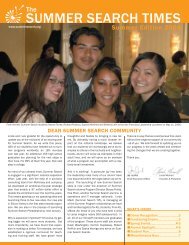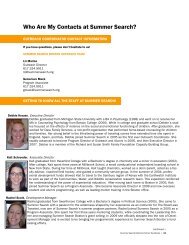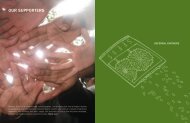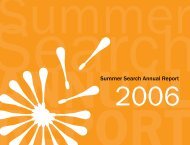CAREER COACH HANDBOOK - Summer Search
CAREER COACH HANDBOOK - Summer Search
CAREER COACH HANDBOOK - Summer Search
Create successful ePaper yourself
Turn your PDF publications into a flip-book with our unique Google optimized e-Paper software.
INTERESTS<br />
Biking, gourmet cooking, trekking and reading books on politics and history.<br />
Additional Resources:<br />
Skill Set Descriptive Examples<br />
Computer Skills: Microsoft Powerpoint, Microsoft Excel, Microsoft Word, Microsoft Access,<br />
Quickbooks, Photoshop, website development, social media websites proficiency (twitter,<br />
facebook, etc.)<br />
Personal Skills: Highly organized, detail oriented, excellent people and communication skill,<br />
self starter, foreign language fluency exceptional attention to detail, ability to effectively multitask<br />
in a deadline driven atmosphere. Outstanding written and verbal skills as well as<br />
interpersonal skills, superior analytical, critical thinking and problem solving skills, selfmotivated<br />
go-getter who is driven to achieve results creatively<br />
Links to good websites:<br />
http://www.collegegrad.com/jobsearch/Best-College-Resumes/Sample-Resume/<br />
http://www.eresumes.com/entry-level-resume.html<br />
http://jobsearch.about.com/od/teenstudentgrad/a/studentresume.htm<br />
Links for lists of action words:<br />
http://www.bc.edu/offices/careers/skills/resumes/verbs.html<br />
http://www.professional-resume-example.com/resume-keywords.html<br />
Proofreading Checklist<br />
1. Spelling - use your word processor but read it yourself carefully. Ask two people who are not<br />
familiar with your resume proofread it for spelling and grammar.<br />
2. Punctuation - Read your resume backwards several times while looking for any missing or<br />
incorrect punctuation. Also check that you are using punctuation consistently.<br />
3. Layout and Spacing - make sure your use of margins, type fonts, type styles, space between<br />
sections, etc. is consistent and pleasing to the eye. Make sure it has white space and does not look<br />
too dense.<br />
4. Numbers and Facts - double-check all of your dates, numbers and figures for consistency.<br />
5. Clarity and Content - read your resume out loud to several different people to check for any<br />
awkward, missing or extra words. Ask yourself, is this communicating what I had hoped<br />
6. Confirm Contact Information - make sure you verify that your name, address, zip code and any<br />
other personal contact information is correct and current.<br />
2. Resume Formatting Guidelines<br />
Formatting a Resume<br />
• Stick to traditional format - Creative work for professions such as graphic arts,<br />
architecture and advertising can be shown in portfolios or books and should not interfere<br />
with the resume format.<br />
• Use a common word processing program - Resumes are often updated and<br />
modified. Use a program that is easily accessed such as MS Word.<br />
• Aim for a one-page resume - Multiple pages can be lost or separated. Use the<br />
following tools to keep information concise: font size, phrasing alternatives and editing.<br />
• Keep it Visually Simple - Limit indentations and italics. Limit font sizes to 10 pts to 12<br />
pts; 12 pts is best; do not use smaller than 10 pts. Do not use more than 2 types of fonts<br />
and 2 font sizes.<br />
• Ink Colors - Use black ink.<br />
• Paper Format - Use 8.5” x 11” high quality, heavy weight bond paper in conservative<br />
<br />
32









